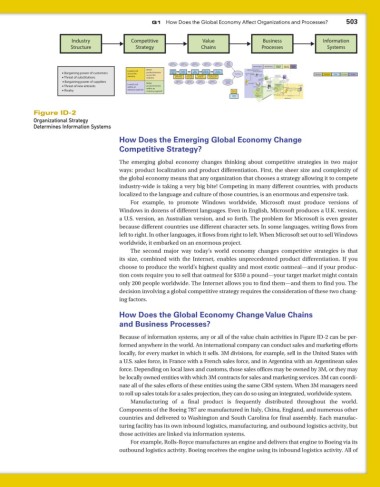Page 535 - Using MIS
P. 535
Q1 How Does the Global Economy Affect Organizations and Processes? 503
Industry Competitive Value Business Information
Structure Strategy Chains Processes Systems
Total
Margin = Margin = Margin = Margin = Margin = Margin,
Value – Cost Value – Cost Value – Cost Value – Cost Value – Cost Primary
Activities Outbound Sales and Customer
Inbound Logistics Manufacturing
Logistics Marketing Service
Lowest cost Better Acquire Produce Ship Market & Service Materials Ordering Process
Purchase Bicycle Parts
• Bargaining power of customers across the product/service Bicycle Parts Bicycle Bicycles Sell Bicycles Customers Total Margin Raw Materials Order Parts Hardware Software Data Procedures People
Hire & Support
Investigate
Update with
• Threat of substitutions industry across the Manage Supplier New Designs (Human Resources) Manage Company Cash Query Database Materials Raw Finished Bicycle Finished Goods
Employees
Resources (Firm
Relationships
industry
(Technology)
(Procurement)
Database
Infrastructure)
Parts Received
• Bargaining power of suppliers Better Value – Cost Value – Cost Value – Cost Value – Cost Total Margin, Update with Update with Shipped Bicycles Bicycle
Margin =
Margin =
Update with Query
Margin =
Margin =
Support
Parts Used
Activities
• Threat of new entrants Lowest cost product/service Vendor Raw Materials Receiving Components Finished Goods Salesperson Customer
within an
Inventory
Sales Pitch
• Rivalry industry segment within an Primary Accepted Make Bicycle Finished Bicycles Customer Order
Bicycle
Materials
industry segment
Cash
Activity
Approved
Order
Support Raw Materials Shipping Boxed Bicycles
Activity Inventory Manufacturing Process Sales Process
Figure ID-2
Organizational Strategy
Determines Information Systems
How Does the Emerging Global Economy Change
Competitive Strategy?
The emerging global economy changes thinking about competitive strategies in two major
ways: product localization and product differentiation. First, the sheer size and complexity of
the global economy means that any organization that chooses a strategy allowing it to compete
industry-wide is taking a very big bite! Competing in many different countries, with products
localized to the language and culture of those countries, is an enormous and expensive task.
For example, to promote Windows worldwide, Microsoft must produce versions of
Windows in dozens of different languages. Even in English, Microsoft produces a U.K. version,
a U.S. version, an Australian version, and so forth. The problem for Microsoft is even greater
because different countries use different character sets. In some languages, writing flows from
left to right. In other languages, it flows from right to left. When Microsoft set out to sell Windows
worldwide, it embarked on an enormous project.
The second major way today’s world economy changes competitive strategies is that
its size, combined with the Internet, enables unprecedented product differentiation. If you
choose to produce the world’s highest quality and most exotic oatmeal—and if your produc-
tion costs require you to sell that oatmeal for $350 a pound—your target market might contain
only 200 people worldwide. The Internet allows you to find them—and them to find you. The
decision involving a global competitive strategy requires the consideration of these two chang-
ing factors.
How Does the Global Economy Change Value Chains
and Business Processes?
Because of information systems, any or all of the value chain activities in Figure ID-2 can be per-
formed anywhere in the world. An international company can conduct sales and marketing efforts
locally, for every market in which it sells. 3M divisions, for example, sell in the United States with
a U.S. sales force, in France with a French sales force, and in Argentina with an Argentinean sales
force. Depending on local laws and customs, those sales offices may be owned by 3M, or they may
be locally owned entities with which 3M contracts for sales and marketing services. 3M can coordi-
nate all of the sales efforts of these entities using the same CRM system. When 3M managers need
to roll up sales totals for a sales projection, they can do so using an integrated, worldwide system.
Manufacturing of a final product is frequently distributed throughout the world.
Components of the Boeing 787 are manufactured in Italy, China, England, and numerous other
countries and delivered to Washington and South Carolina for final assembly. Each manufac-
turing facility has its own inbound logistics, manufacturing, and outbound logistics activity, but
those activities are linked via information systems.
For example, Rolls-Royce manufactures an engine and delivers that engine to Boeing via its
outbound logistics activity. Boeing receives the engine using its inbound logistics activity. All of

